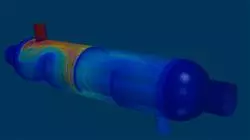University certificate
The world's largest faculty of engineering”
Description
Become an expert in Fluid Modeling in only 6 months"

One of the keys to the study of turbulence is that it cannot be calculated but rather modeled. Even in the case of research, it is done in very simplified domains, using the largest computers in the world for several months. This time and these resources are unattainable for the vast majority of companies, but one of the great advantages of modeling is that it avoids these problems. As a result, the demand for professionals with specialized knowledge in this area continues to increase.
This is the reason why TECH has designed a postgraduate diplomain Fluid Modeling, to provide students with advanced skills and knowledge in this area, which can guarantee them a successful future as engineers in this field.
Thus, this study plan offers a complete and accurate deepening in topics such as RANS Methods, LES Evolution, the Riemann Problem, Multiphase Flow or Bidirectional Cosimulation, among many other aspects of great relevance.
All this, through a convenient 100% online modality that allows students to combine their studies with their other main obligations, without the need to travel or fixed schedules. In addition, with the possibility of accessing all the theoretical and practical material from the first day, with total freedom and from any device with internet connection, whether mobile, computer or tablet.
Acquire updated knowledge in Fluid Modeling and stand out in a booming sector"
This postgraduate diploma in Fluid Modeling contains the most complete and up-to-date program on the market. The most important features include:
- The development of case studies presented by experts in Fluid Modeling
- The graphic, schematic, and practical contents with which they are created, provide scientific and practical information on the disciplines that are essential for professional practice
- Practical exercises where self-assessment can be used to improve learning
- Its special emphasis on innovative methodologies
- Theoretical lessons, questions to the expert, debate forums on controversial topics, and individual reflection assignments
- Content that is accessible from any fixed or portable device with an Internet connection
Deepen your knowledge and acquire new skills in Convective Heat Transfer or Bidirectional Cosimulation"
The program’s teaching staff includes professionals from the sector who contribute their work experience to this educational program, as well as renowned specialists from leading societies and prestigious universities.
Its multimedia content, developed with the latest educational technology, will provide the professional with situated and contextual learning, i.e., a simulated environment that will provide an immersive education programmed to learn in real situations.
The design of this program focuses on Problem-Based Learning, by means of which the professional must try to solve the different professional practice situations that are presented throughout the academic course. For this purpose, the student will be assisted by an innovative interactive video system created by renowned experts.
Enroll now and access all the content in Fluid Modeling, with no time limits or need to travel"

Learn all about Solid-Fluid Thermal Coupling, thanks to the most complete theoretical and practical material"
Objectives
The objective of this postgraduate diploma in Fluid Modeling is to provide students with specialized knowledge in this subject, so that they can face their work as engineers in this area with total guarantee of success and being able to solve any inconvenience they may have to face. All this, thanks to the most complete, accurate and updated contents in the academic market.

Enhance your professional profile and get a position in one of the most promising areas of engineering"
General Objectives
- Establish the basis for the study of turbulence
- Develop CFD statistical concepts
- Determine the main computational techniques in turbulence research
- Generate specialized knowledge in the method of Finite Volumes
- Acquire specialized knowledge in fluid mechanics calculation techniques
- Examine the wall units and the different regions of a turbulent wall flow
- Determine the characteristics of compressible flows
- Examine multiple models and multiphase methods
- Develop expertise on multiple models and methods in multiphysics and thermal analysis
- Interpret the results obtained by correct post-processing
Specific Objectives
Module 1. Modeling of turbulence in Fluid
- Applying the concept of orders of magnitude
- Present the problem of closure of the Navier-Stokes equations
- Examine energy budget equations
- Develop the concept of turbulent viscosity
- Substantiate the different types of RANS and LES
- Present the regions of a turbulent flow
- Model the energy equation
Module 2. Compressible Fluids
- Develop the main differences between compressible and incompressible flow
- Examine typical examples of the occurrence of compressible fluids
- Identify the peculiarities in the solution of hyperbolic differential equations
- Establish the basic methodology for solving the Riemann problem
- Compile different resolution strategies
- Analyze the pros and cons of the different methods
- Present the applicability of these methodologies to the Euler / Navier-Stokes equations, showing classical examples
Module 3. Multiphase flow
- Distinguish what type of multiphase flow is to be simulated: continuous phases, such as simulating a ship at sea, a continuous medium; discrete phases, such as simulating specific droplet trajectories; or use statistical populations when the number of particles, droplets or bubbles is too large to be simulated
- Establish the difference between Lagrangian, Eulerian and mixed methods
- Determine the tools best suited to the type of flow to be simulated
- Modeling the effects of surface tension and phase changes such as evaporation, condensation or capitation
- Develop boundary conditions for wave simulation, learn about the different wave models and apply the so-called numerical beach, a region of the domain located at the exit whose objective is to avoid wave reflection
Module 4. Advanced CFD Models
- Distinguish what type of physical interactions are to be simulated: fluid-structure, such as a wing subject to aerodynamic forces, fluid coupled with rigid body dynamics, such as simulating the motion of a buoy floating in the sea, or thermofluid, such as simulating the distribution of temperatures in a solid subject to air currents
- Distinguish the most common data exchange schemes between different simulation software and when one or the other can or is best to be applied
- Examine the various heat transfer models and how they can affect a fluid
- Model convection, radiation and diffusion phenomena from a fluid point of view, model sound creation by a fluid, model simulations with advection-diffusion terms to simulate continuous or particulate media and model reactive flows

Reach your most demanding goals, thanks to a unique opportunity to expand your knowledge in Fluid Modeling"
Postgraduate Certificate in Fluid Modeling
The ability to model and simulate fluid behavior is critical in a wide variety of areas, from engineering to medicine to materials science. For this reason, at TECH Global University we have developed our Postgraduate Diploma in Fluid Modeling program, focused on training experts capable of designing and executing advanced numerical simulations of fluid processes in different contexts. This program provides a solid theoretical foundation in fluid mechanics, thermodynamics and numerical methods, complemented with the teaching of specialized software tools and laboratory practices.
In our Postgraduate Diploma, participants will be able to develop skills for the analysis and simulation of fluid flow processes in complex situations, such as the interaction of fluids with structures, the behavior of non-Newtonian fluids, and the dynamics of gases and liquids in multi-component systems. In addition, the application of fluid modeling in specific areas, such as biomedicine and the energy industry, will be studied in depth. At the end of the program, graduates will be able to apply their knowledge in solving practical problems in the working world and in research in engineering, physics and applied sciences in general.







